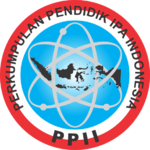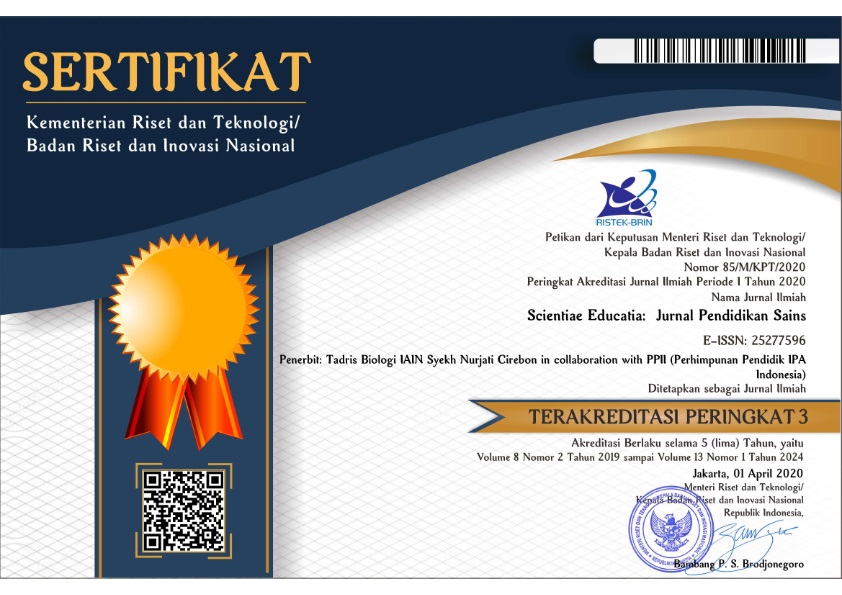Desain Eksperimen Karakterisasi Perilaku Udara Sekitar dalam Tinjauan Sebagai Gas Ideal atau Gas Nyata
(1) Program Studi Fisika, Fakultas Sains dan Matematika, Universitas Kristen Satya Wacana, Salatiga, (Scopus Id: 56375129000)
(2) Pogram Studi Pendidikan Fisika, Fakultas Sains dan Matematika, Universitas Kristen Satya Wacana, Salatiga
(3) Pogram Studi Pendidikan Fisika, Fakultas Sains dan Matematika, Universitas Kristen Satya Wacana, Salatiga
(4) Pogram Studi Pendidikan Fisika, Fakultas Sains dan Matematika, Universitas Kristen Satya Wacana, Salatiga
(5) Pogram Studi Pendidikan Fisika, Fakultas Sains dan Matematika, Universitas Kristen Satya Wacana, Salatiga
(*) Corresponding Author
Abstract
The aim of this study is to characterize the behavior of the environmental air using a simple method which can be implemented as a learning media in senior high school or undergraduate students. The method used is experimental which combined with curve fitting. From the curve fitting step, the behavior of the air can be explained. Otherwise, the quantitative data such as Van der Waals constants can also be obtained. From this study obtained that the Van der Waals constants, a and b, of the chosen air samples as large as (11.23 ± 0.84) J.m3/mol2 and (2.04 ± 0.15) × 10-3 m3/mol respectively. These results can be used to predict that the chosen air samples will act as an ideal gas at 636.5 K and 105 Pa in temperature and pressure respectively.
Tujuan dari penelitian ini untuk mengetahui perilaku udara sekitar dalam tinjauan sebagai gas ideal atau gas nyata dengan metode sederhana yang dapat diterapkan sebagai media pembelajaran baik di tingkat perguruan tinggi maupun sekolah menengah atas. Metode yang digunakan adalah eksperimen yang dipadukan dengan pencocokan kurva. Informasi terkait kecenderungan perilaku udara sekitar diperoleh dari tahapan pencocokan kurva. Nilai kuantitatif yang berupa konstanta Van der Waals dari sampel udara sekitar juga dapat diperoleh dari persamaan hasil pencocokan kurva yaitu a dan b secara berturut-turut sebesar (11.23 ± 0.84) J.m3/mol2 dan (2.04 ± 0.15) × 10-3 m3/mol. Nilai konstanta yang diperoleh dapat digunakan untuk memprediksi bahwa sampel udara yang diamati akan berperilaku sebagai gas ideal ketika bersuhu 636.5 K dengan tekanan 105 Pa.
Keywords
Full Text:
PDFReferences
Aydeniz, M., Pabuccu, A., Cetin, P.S., & Kaya, E. (2012). Argumentation and students’ conceptual understanding of properties and behaviors of gases. International Journal of Science and Mathematical Education. 10, 1303–1324. DOI: 10.1007/s10763-012-9336-1
Ayyıldız, Y., & Tarhan, L. (2013). Case study applications in chemistry lesson: gases, liquids, and solids. Chem. Educ. Res. Pract. 14, 408–420. DOI: 10.1039/C3RP20152J
Berberan-Santos, M.N., Bodunov, E.N., & Pogliani, L.(2008). The van der Waals equation: analytical and approximate solutions. Journal of Mathematical Chemistry. 43, 1437–1457. DOI: 10.1007/s10910-007-9272-4
De Visser, S.P. (2011). Van der Waals equation of state revisited: importance of the dispersion correction. J. Phys. Chem. B 115, 4709–4717. DOI: 10.1021/jp200344e
Greene, C.A., Wilson, P.S. (2011). Laboratory investigation of a passive acoustic method for measurement of underwater gas seep ebullition. The Journal of the Acoustical Society of America. 131, EL61–EL66. DOI: 10.1121/1.3670590
Hammar, M. (2013). Teaching the gas properties and gas laws: an inquiry unit with alternative assessment. Diss. Masters Theses Masters Rep. - Open. Available online: http://digitalcommons.mtu.edu/etds/698/
Kautz, C.H., Heron, P.R.L., Loverude, M.E., & McDermott, L.C. (2005). Student understanding of the ideal gas law, part I: a macroscopic perspective. Am. J. Phys. 73, 1055–1063. DOI: 10.1119/1.2049286
Kibar, Z.B., Yaman, F., & Ayas, A. (2013). Assessing prospective chemistry teachers’ understanding of gases through qualitative and quantitative analyses of their concept maps. Chem. Educ. Res. Pract. 14, 542–554. DOI: 10.1039/C3RP00052D
Koponen, I.T., & Mäntylä, T. (2006). Generative role of experiments in physics and in teaching physics: a suggestion for epistemological reconstruction. Sci. Educ. 15, 31–54. DOI: 10.1007/s11191-005-3199-6
Krišťák, Ľ., Němec, M., Ján, S., & Zuzana, D. (2013). Interactive P&E method in teaching physics at secondary schools. Journal of Technology and Information Education 5, 42–50. DOI: 10.5507/jtie.2013.006
LukÅ¡iÄ, M., Fennell, C.J., & Dill, K.A. (2014). Using interpolation for fast and accurate calculation of ion–ion interactions. J. Phys. Chem. B 118, 8017–8025. DOI: 10.1021/jp501141j
Metsämäki, S., Vepsäläinen, J., Pulliainen, J., & Sucksdorff, Y. (2002). Improved linear interpolation method for the estimation of snow-covered area from optical data. Remote Sens. Environ. 82, 64–78. DOI: 10.1016/S0034-4257(02)00025-1
Noor, N.M., Abdullah, A.B., Mustafa, M., Yahaya, A.S., & Ramli, N.A. (2015). Comparison of linear interpolation method and mean method to replace the missing values in environmental data set. Mater. Sci. Forum 803, 278–281. DOI: 10.4028/www.scientific.net/MSF.803.278
Roehrig, G., & Garrow, S. (2007). The impact of teacher classroom practices on student achievement during the implementation of a reformâ€based chemistry curriculum. Int. J. Sci. Educ. 29, 1789–1811. DOI: 10.1080/09500690601091865
Ross, S.M., Morrison, G.R., & Lowther, D.L., (2005). Using experimental methods in higher education research. J. Comput. High. Educ. 16, 39–64. DOI: 10.1007/BF02961474
Saaban, A., Zainudin, L., & Bakar, M.N.A. (2015). Evaluation of linear interpolation method for missing value on solar radiation dataset in Perlis. AIP Conf. Proc. 1660, 050024. DOI: 10.1063/1.4915657
Said, A.S., & Al-ameeri R. S. (1987). Curve fitting in science and technology. Sep. Sci. Technol. 22, 65–84. DOI: 10.1080/01496398708056158
Schuttlefield, J.D., Kirk, J., Pienta, N.J., & Tang, H. (2012). Investigating the effect of complexity factors in gas law problems. J. Chem. Educ. 89, 586–591. DOI: 10.1021/ed100865y
Shao, C., Fang, F., Bai, F., & Wang, B. (2014). An interpolation method combining snurbs with window interpolation adjustment. IEEE, pp. 176–179. DOI: 10.1109/ICIST.2014.6920359
Stern, C., EcheverrÃa, C., & Porta, D. (2017). Teaching Physics through Experimental Projects. Procedia IUTAM, 24th International Congress of Theoretical and Applied Mechanics 20, 189–194. DOI: 10.1016/j.piutam.2017.03.026
DOI: 10.24235/sc.educatia.v6i2.1823
Article Metrics
Abstract view : 1292 timesPDF - 1484 times
Refbacks
- There are currently no refbacks.
Scientiae Educatia: Jurnal Pendidikan Sains indexed by:

This work is licensed under a Creative Commons Attribution 4.0 International License.



1.png)












